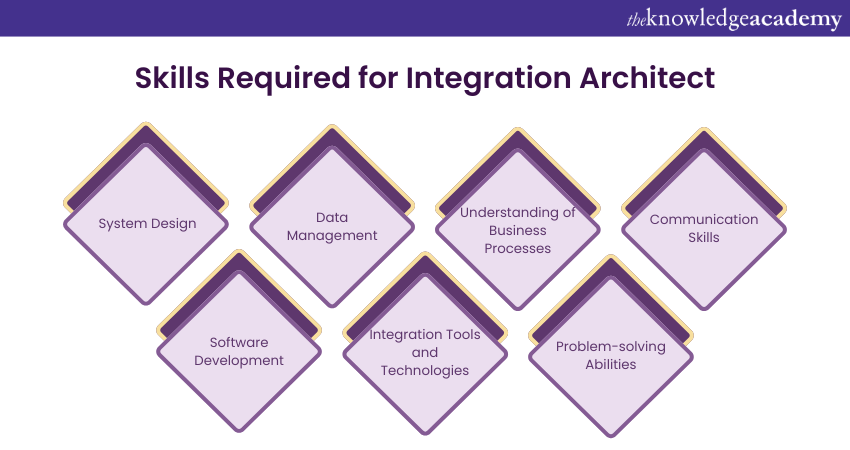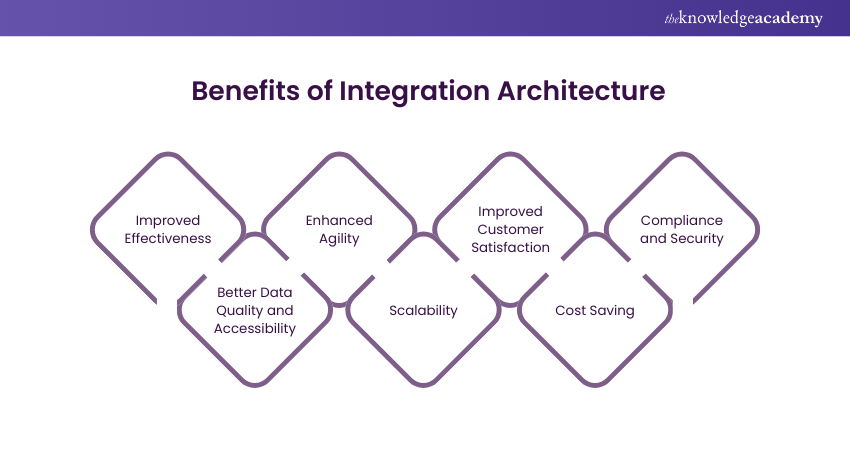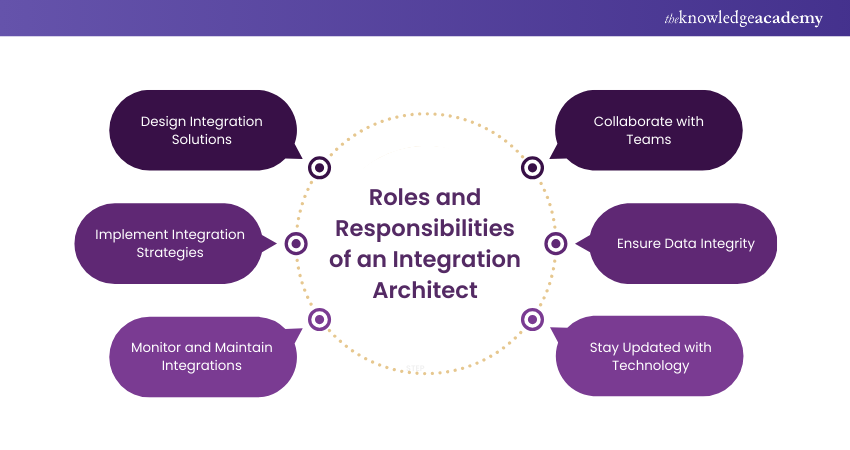We may not have the course you’re looking for. If you enquire or give us a call on +91 8037244591 and speak to our training experts, we may still be able to help with your training requirements.
Training Outcomes Within Your Budget!
We ensure quality, budget-alignment, and timely delivery by our expert instructors.

Start a journey to the heart of the digital ecosystem with Integration Architecture. Imagine it as a universal translator for applications, enabling them to communicate seamlessly across different platforms. Understand What is Integration Architecture" and "Who is an Integration Architect", detailing their skills, roles, and responsibilities through this blog.
Integration Architects are the tech maestros who orchestrate this harmony. They ensure that data flows securely from point A to point B, making our digital experiences efficient and smooth. So, let’s simplify the roles that make our digital experiences seamless and efficient!
Table of Contents
1) Who is the Integration Architect?
2) Understanding What is Integration Architecture
3) Skills Required for Integration Architect
4) Types of Integration Architecture
5) Benefits of Integration Architecture
6) Components Integration Architecture
7) Roles and Responsibilities of an Integration Architect
8) Average Salary for Integration Architect
Who is the Integration Architect?
An Integration Architect designs and implements solutions that ensure different software systems work together seamlessly. They focus on creating efficient data flow and connectivity between applications, ensuring smooth and cohesive system operations. Their role is crucial in maintaining system integration and overall functionality.

Understanding What is Integration Architecture
Integration Architecture represents a systematic approach and a detailed plan that outlines how an organisation’s array of software applications, systems, and technological assets can function together compatibly. This encompasses the strategies for design and execution, as well as the instruments and middleware solutions that facilitate efficient links and data exchange among different IT landscapes.
It is comparable to constructing a universal connector. Such an architectural framework ensures the effortless transfer and amalgamation of information throughout the various systems within an organisation.
Skills Required for Integration Architect
Here are the skills required for Integration Architect:

a) System Design: An Integration Architect must be skilled in creating architectures that ensure seamless integration between different systems. This involves understanding how systems interact and designing frameworks that support smooth data flow.
b) Software Development: Proficiency in coding and software development is crucial for an Integration Architect. They need to write and implement code that enables different systems to communicate and work together.
c) Data Management: Knowledge of managing data flows and ensuring data integrity across systems is vital. An Integration Architect must ensure that data is accurately transferred and maintained between systems.
d) Integration Tools and Technologies: Familiarity with various tools and technologies used for system integration is important. An Integration Architect should know how to leverage these tools to facilitate smooth integration.
e) Understanding of Business Processes: Insight into business operations is necessary to align integration solutions with business needs. An Integration Architect must understand the workflows and requirements of the business. This knowledge helps create integration strategies that support and enhance business processes.
f) Problem-solving Abilities: Analytical skills are required to identify and resolve integration issues effectively. They need to troubleshoot problems and develop solutions quickly. Their problem-solving abilities are crucial for maintaining the reliability and efficiency of integrated systems.
g) Communication Skills: Excellent communication is essential for collaborating with different teams and stakeholders. An Integration Architect must convey technical information clearly to non-technical team members.
Types of Integration Architecture
Integration Architecture includes different methods to help systems communicate and share data effectively. Let's explore:
a) Point-to-Point Integration: This type connects systems directly to each other. It's good for small setups but can get complicated as more connections are added. Managing many direct connections can become difficult.
b) Hub-and-Spoke Integration: This type uses a central hub to manage data flow between systems. It simplifies connections by having each system connected to the hub instead of directly to each other. This makes managing and updating integrations easier.
c) Enterprise Service Bus (ESB): An ESB acts as a common bus for systems to communicate through. It provides flexibility and scalability by allowing different systems to connect through a central platform. This makes it easier to integrate and manage multiple systems.
d) Microservices Architecture: This approach breaks applications into small, independent services. Each service communicates with others through APIs. This makes it easier to update, scale, and maintain each part of the application.
e) API-led Integration: This type uses APIs to connect different systems. APIs provide standardised methods for integration, making it easier to manage and maintain connections. This approach allows for reusable and consistent integration solutions.
Attain knowledge of networking, server, and storage architectures with our Information Architecture Training Course – join today!
Benefits of Integration Architecture
Integration Architecture acts as the backbone for various technological systems within an organisation, facilitating effective communication and leading to several benefits:

1) Improved Effectiveness: Integration Architecture enables the sharing of data and processes across various systems, eliminating redundancy of efforts and streamlining operations. This can significantly reduce the resources and time needed to carry out tasks.
2) Better Data Quality and Accessibility: Efficient system integration allows organisational data to be shared and updated in real-time. Minimises errors and ensures decision-makers can access valid and current information.
3) Enhanced Agility: The ever-changing business world demands readiness for change. Integration Architecture offers flexibility, allowing the IT environment to integrate new technologies or processes without interrupting operations.
4) Scalability: As the company grows, so does its IT system. The proper Integration Architecture grows with the business, supporting new integrations and data volumes without a decrease in performance.
5) Improved Customer Satisfaction: Integrating backend systems, like inventory management, with frontend systems, like e-commerce platforms, leads to seamless service delivery. This results in better response times, personalisation, and service efficiency.
6) Cost Saving: Although setting up an Integration Architecture requires an initial investment, significant long-term cost savings are realised through reduced manual labour, fewer errors, and lower maintenance costs.
7) Compliance and Security: Data is an important asset, so consistency and security measures are paramount. Integration Architecture enforces data governance policies and security measures across all systems, aiding compliance with regulatory requirements.
Components of Integration Architecture
Here is the list of components that makes Integration Architecture:
a) Data Source: This is where the data comes from, like databases, applications, or external systems. It's the origin point for all the information that needs to be integrated.
b) Middleware: Middleware is software that connects different systems, enabling them to communicate and exchange data. It acts as a bridge to facilitate smooth data flow.
c) API Gateway: An API Gateway manages and routes API requests, providing a secure way to connect services. It ensures that all API interactions are handled efficiently and safely.
d) Message Queue: A message queue allows systems to communicate asynchronously by storing and forwarding messages. This helps in managing the load and timing of data exchange.
e) Data Transformation Tools: These tools convert data into the required format for different systems to understand and use. They ensure compatibility and seamless data integration.
f) Monitoring and Management Tools: These tools track the performance and health of integrations. They make sure that all systems are running smoothly and any issues are quickly addressed.
Learn to gather integration requirements with our Integration Architect Training – join today!
Roles and Responsibilities of an Integration Architect
Integration Architecture includes different methods to help systems communicate and share data effectively. Let's explore:

a) Design Integration Solutions: An Integration Architect creates architectures to ensure different systems work together seamlessly. They develop detailed plans for integrating new systems with existing ones. This involves understanding system requirements and designing effective integration frameworks.
b) Implement Integration Strategies: They deploy and configure integration tools and middleware to facilitate smooth communication between systems. Ensuring that integration solutions are implemented correctly is a key part of their role. They also work to optimise these solutions for performance and reliability.
c) Monitor and Maintain Integrations: Regular monitoring of integration systems is important to ensure they are functioning correctly. They resolve any issues that arise to maintain system performance. This involves ongoing maintenance and updates to integration configurations.
d) Collaborate with Teams: An Integration Architect works closely with development, operations, and business teams to align integration efforts with overall business goals. They communicate technical requirements and integration strategies clearly to all stakeholders. Effective collaboration helps ensure successful integration projects.
e) Ensure Data Integrity: Maintaining the accuracy and consistency of data across integrated systems is crucial. They implement data management and transformation processes to ensure data integrity. This helps prevent data discrepancies and ensure reliable information flow.
f) Stay Updated with Technology: Knowing the new integration tools and technologies is important for continuous improvement. They stay informed about new developments and best practices in the field. This knowledge helps them to continuously improve integration processes and strategies.
Average Salary for Integration Architect
Below is a table showing the average salaries of Integration Architect in the specified countries:
|
Country |
Average Salary (Yearly) |
|
UK |
£68,918 |
|
US |
$122,158 |
|
India |
₹1,986,415 |
|
Australia |
AUD138,939 |
|
Canada |
$117,250 |
|
UAE |
AED240,000 |
|
Singapore |
SGD108,000 |
Source: Glassdoor
Note: Please remember that these figures depend on factors such as experience, location, and company size.
Conclusion
Understanding "What is Integration Architecture?" and "Who is an Integration Architect?" is essential for creating seamless and efficient system operations. By leveraging the right Integration Architecture and tools, businesses can enhance their workflows, reduce complexity, and achieve a more connected and efficient system environment.
Learn how to translate business requirements into Integration requirements with our Enterprise Integration Advanced Course.
Frequently Asked Questions

The best system Integration Architecture depends on your specific needs and the complexity of your systems. For small setups, point-to-point integration might work well, while larger, more complex systems benefit from using an Enterprise Service Bus (ESB) or microservices architecture.

For system integration, common tools include MuleSoft, Dell Boomi, and Apache Camel. These tools help connect different systems, manage data flow, and ensure seamless communication between applications.

The Knowledge Academy takes global learning to new heights, offering over 30,000 online courses across 490+ locations in 220 countries. This expansive reach ensures accessibility and convenience for learners worldwide.
Alongside our diverse Online Course Catalogue, encompassing 17 major categories, we go the extra mile by providing a plethora of free educational Online Resources like News updates, Blogs, videos, webinars, and interview questions. Tailoring learning experiences further, professionals can maximise value with customisable Course Bundles of TKA.

The Knowledge Academy’s Knowledge Pass, a prepaid voucher, adds another layer of flexibility, allowing course bookings over a 12-month period. Join us on a journey where education knows no bounds.

The Knowledge Academy offers various Enterprise Architect Training, including the Certified Enterprise Architect Professional (CEAP) Course, BCS Foundation and Practitioner Certificate in Enterprise and Solution Architecture Course, and Enterprise Integration Fundamentals Training. These courses cater to different skill levels, providing comprehensive insights into Big Data Integration.
Our Business Improvement Blogs cover a range of topics related to Enterprise Architect Training, offering valuable resources, best practices, and industry insights. Whether you are a beginner or looking to advance your Enterprise Architect skills, The Knowledge Academy's diverse courses and informative blogs have got you covered.
Upcoming Business Improvement Resources Batches & Dates
Date
 Certified Enterprise Architect Professional (CEAP)
Certified Enterprise Architect Professional (CEAP)
Thu 1st Jan 1970







 Top Rated Course
Top Rated Course


 If you wish to make any changes to your course, please
If you wish to make any changes to your course, please


